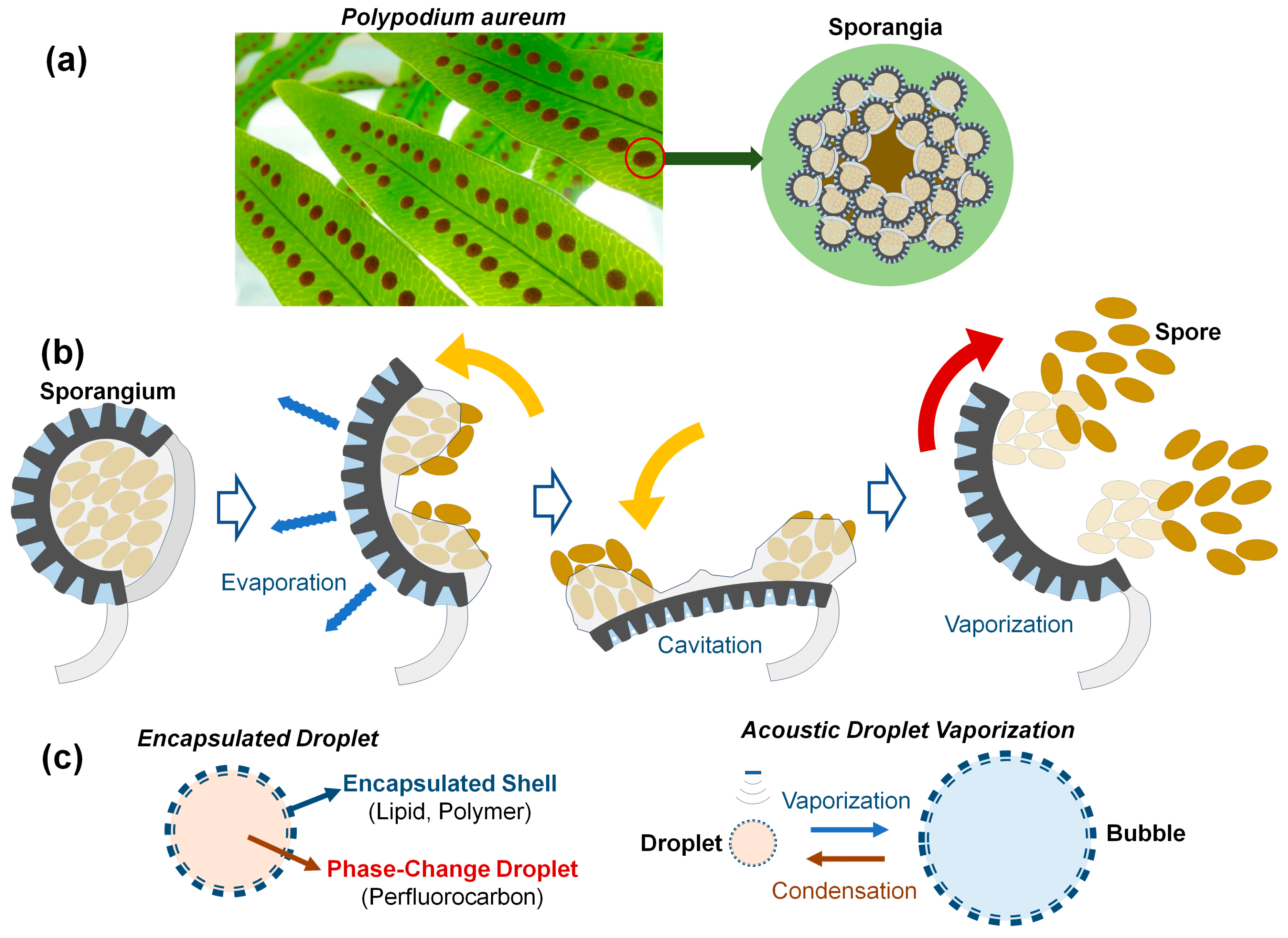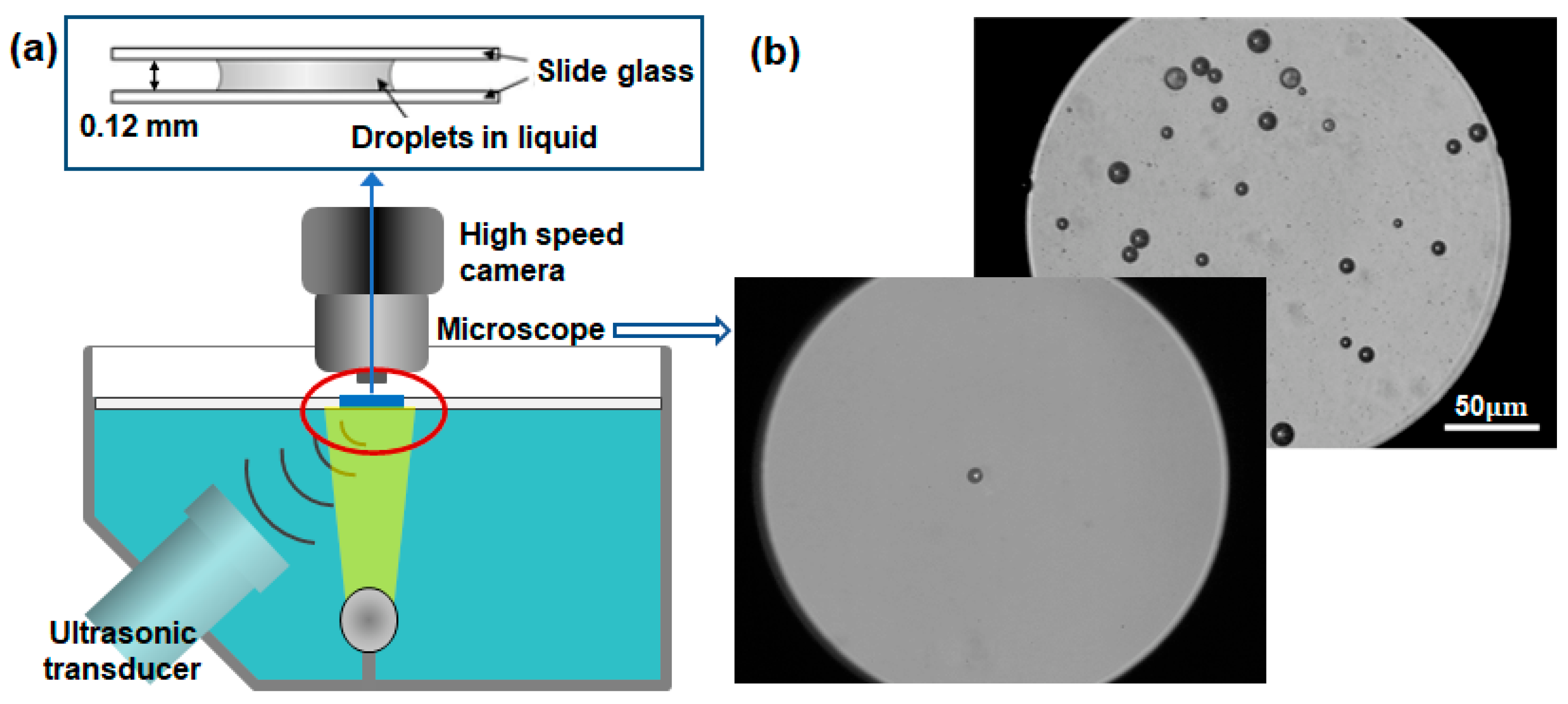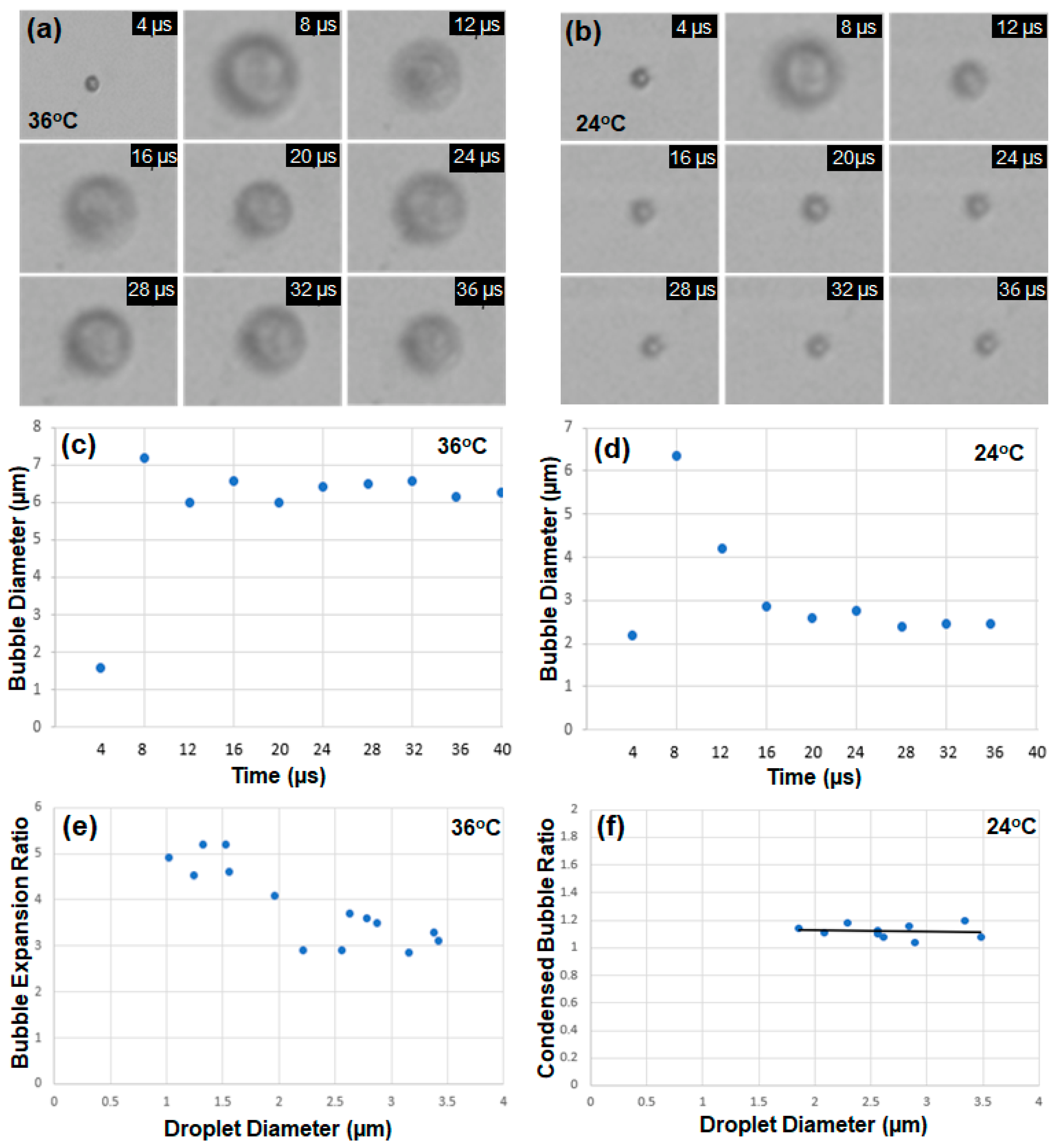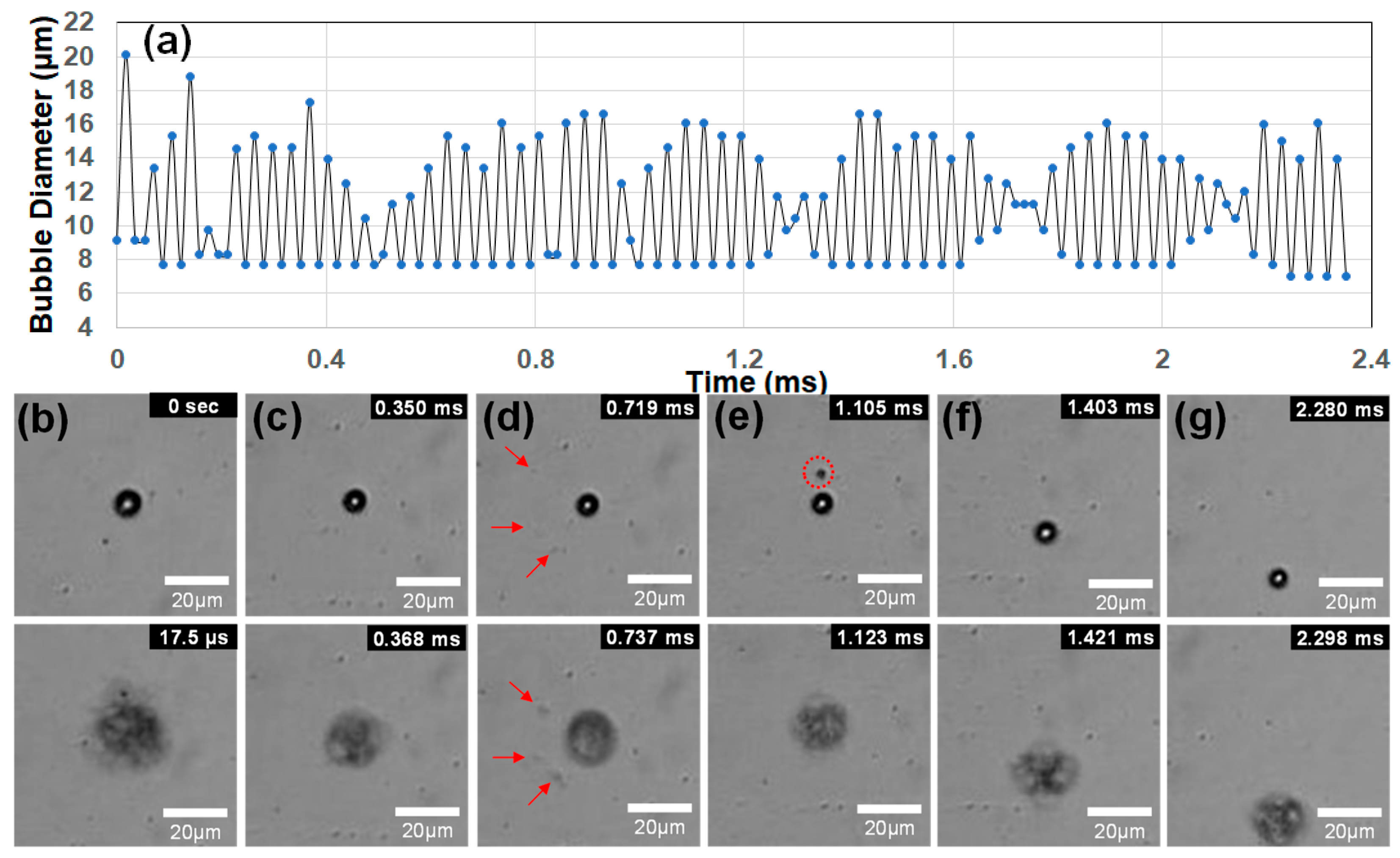Repeatable Acoustic Vaporization of Coated Perfluorocarbon Bubbles for Micro-Actuation Inspired by Polypodium aureum
Abstract
1. Introduction
2. Materials and Methods
2.1. Materials
2.2. Experimental Setup
3. Results and Discussion
3.1. Recondensation after Vaporization and Bubble Collapse
3.2. Repetitive Vaporization–Condensation
3.3. Future Direction for Micro-Sized Actuation and Biomedical Applications
4. Conclusions
Author Contributions
Funding
Institutional Review Board Statement
Data Availability Statement
Conflicts of Interest
References
- Upadhyay, A.; Dalvi, S.V. Microbubble Formulations: Synthesis, Stability, Modeling and Biomedical Applications. Front. Pharmacol. 2019, 45, 301–343. [Google Scholar] [CrossRef]
- Paefgen, V.; Doleschel, D.; Kiessling, F. Evolution of Contrast Agents for Ultrasound Imaging and Ultrasound-Mediated Drug Delivery. Ultrasound Med. Biol. 2015, 6, 197. [Google Scholar] [CrossRef]
- Lea-Banks, H.; O’Reilly, M.A.; Hynynen, K. Ultrasound-Responsive Droplets for Therapy: A Review. J. Control. Release 2019, 293, 144–154. [Google Scholar] [CrossRef]
- Li, J.; de Ávila, B.E.-F.; Gao, W.; Zhang, L.; Wang, J. Micro/Nanorobots for Biomedicine: Delivery, Surgery, Sensing, and Detoxification. Sci. Robot. 2017, 2, eaam6431. [Google Scholar] [CrossRef] [PubMed]
- Chen, X.Z.; Jang, B.; Ahmed, D.; Hu, C.; De Marco, C.; Hoop, M.; Mushtaq, F.; Nelson, B.J.; Pané, S. Small-Scale Machines Driven by External Power Sources. Adv. Mater. 2018, 30, e1705061. [Google Scholar] [CrossRef] [PubMed]
- Wang, B.; Kostarelos, K.; Nelson, B.J.; Zhang, L. Trends in Micro-/Nanorobotics: Materials Development, Actuation, Localization, and System Integration for Biomedical Applications. Adv. Mater. 2021, 33, 202002047. [Google Scholar] [CrossRef] [PubMed]
- Sakes, A.; van der Wiel, M.; Henselmans, P.W.J.; van Leeuwen, J.L.; Dodou, D.; Breedveld, P. Shooting Mechanisms in Nature: A Systematic Review. PLoS ONE 2016, 11, e0158277. [Google Scholar] [CrossRef] [PubMed]
- Noblin, X.; Rojas, N.O.; Westbrook, J.; Llorens, C.; Argentina, M.; Dumais, J. The Fern Sporangium: A Unique Catapult. Science 2012, 335, 1322. [Google Scholar] [CrossRef] [PubMed]
- King, A.L. The Spore Discharge Mechanism of Common Ferns. Proc. Natl. Acad. Sci. USA 1944, 30, 155–161. [Google Scholar] [CrossRef] [PubMed]
- Llorens, C.; Argentina, M.; Rojas, N.; Westbrook, J.; Dumais, J.; Noblin, X. The Fern Sporangium: A Unique Catapult, The Fern Cavitation Catapult: Mechanism and Design Principles. Interface 2016, 13, 25150930. [Google Scholar]
- Aliabouzar, M.; Kripfgans, O.D.; Fowlkes, J.B.; Fabiilli, M.L. Bubble Nucleation and Dynamics in Acoustic Droplet Vaporization: A Review of Concepts, Applications, and New Directions. Z. Med. Phys. 2023, 33, 387–406. [Google Scholar] [CrossRef]
- Borden, M.A.; Kruse, D.E.; Caskey, C.F.; Zhao, S.; Dayton, P.A.; Ferrara, K.W. Influence of Lipid Shell Physicochemical Properties on Ultrasound-Induced Microbubble Destruction. IEEE Trans. Ultrason. Ferroelectr. Freq. Control 2005, 52, 1992–2002. [Google Scholar] [CrossRef]
- Aliabouzar, M.; Kripfgans, O.D.; Estrada, J.B.; Fowlkes, J.B.; Fabiilli, M.L. Multi-Time Scale Characterization of Acoustic Droplet Vaporization and Payload Release of Phase-Shift Emulsions using High-Speed Microscopy. Ultrason. Sonochem. 2022, 88, 106090. [Google Scholar] [CrossRef]
- Namen, A.V.; Jandhyala, S.; Jordan, T.; Luke, G.P. Repeated Acoustic Vaporization of Perfluorohexane Nanodroplets for Contrast-Enhanced Ultrasound Imaging. IEEE Trans. Ultrason. Ferroelectr. Freq. Control 2021, 68, 3497–3506. [Google Scholar] [CrossRef]
- Marmottant, P.; van der Meer, S.; Emmer, M.; Versluis, M.; de Jong, N.; Hilgenfeldt, S.; Lohse, D. A Model for Large Amplitude Oscillations of Coated Bubbles Accounting for Buckling and Rupture. J. Acoust. Soc. Am. 2005, 118, 3499–3505. [Google Scholar] [CrossRef]
- Kwon, S.; Son, G. Experimental Study of Ultrasound-Triggered Vaporization of Microdroplets on a Wall. J. Mech. Sci. Technol. 2022, 36, 1329–1335. [Google Scholar] [CrossRef]
- Seo, H.-B.; Lee, S.-Y. High-Concentration Nanobubble Generation by Megasonic Cavitation and Atomization. Colloid Interface Sci. Commun. 2023, 52, 100687. [Google Scholar] [CrossRef]
- Hernot, S.; Klibanov, A.L. Microbubbles in Ultrasound-Triggered Drug and Gene Delivery. Adv. Drug Deliv. Rev. 2008, 60, 1153–1166. [Google Scholar] [CrossRef]
- Yu, J.; Chen, X.; Villanueva, F.S.; Kim, K. Vaporization and Recondensation Dynamics of Indocyanine Green-Loaded Perfluoropentane Droplets Irradiated by a Short Pulse Laser. Appl. Phys. Lett. 2016, 109, 243701. [Google Scholar] [CrossRef]
- Fabiilli, M.L.; Haworth, K.J.; Fakhri, N.H.; Kripfgans, O.D.; Carson, P.L.; Fowlkes, J.B. The Role of Inertial Cavitation in Acoustic Droplet Vaporization. IEEE Trans. Ultrason. Ferroelectr. Freq. Control 2009, 56, 1006–3497. [Google Scholar] [CrossRef] [PubMed]
- Welch, P.J.; Li, D.S.; Forest, C.R.; Pozzo, L.D.; Shi, C. Perfluorocarbon Nanodroplet Size, Acoustic Vaporization, and Inertial Cavitation Affected by Lipid Shell Composition in vitro. J. Acoust. Soc. Am. 2022, 152, 2493–2504. [Google Scholar] [CrossRef]
- Chattaraj, R.; Goldscheitter, G.M.; Yildirim, A.; Goodwin, A.P. Phase Behavior of Mixed Lipid Monolayers on Perfluorocarbon Nanoemulsions and its Effect on Acoustic Contrast. RSC Adv. 2016, 6, 111318–111325. [Google Scholar] [CrossRef]
- Xiao, Y.; Zhang, J.; Fang, B.; Zhao, X.; Hao, N. Acoustics-Actuated Microrobots. Micromachines 2022, 13, 481. [Google Scholar] [CrossRef] [PubMed]
- Li, J.; Mayorga-Martinez, C.C.; Ohl, C.-D.; Pumera, M. Ultrasonically Propelled Micro- and Nanorobots. Adv. Funct. Mater. 2022, 32, 2102265. [Google Scholar] [CrossRef]
- Gao, Y.; Wu, M.; Lin, Y.; Zhao, W.; Xu, J. Acoustic bubble-based bidirectional micropump. Microfluid. Nanofluid. 2020, 24, 29. [Google Scholar] [CrossRef]
- Jang, D.; Jeon, J.; Chung, S.K. Acoustic Bubble-Powered Miniature Rotor for Wireless Energy Harvesting in a Liquid Medium. Sens. Actuator A Phys. 2018, 276, 296–303. [Google Scholar] [CrossRef]
- Kagan, D.; Benchimol, M.J.; Claussen, J.C.; Chuluun-Erdene, E.; Esener, S.; Wang, J. Acoustic Droplet Vaporization and Propulsion of Perfluorocarbon-Loaded Microbullets for Targeted Tissue Penetration and Deformation. Angew. Chem. 2012, 124, 7637–7640. [Google Scholar] [CrossRef]
- Soto, F.; Martin, A.; Ibsen, S.; Vaidyanathan, M.; Garcia-Gradilla, V.; Levin, Y.; Escarpa, A.; Esener, S.C.; Wang, J. Acoustic Microcannons: Toward Advanced Microballistics. ACS Nano 2016, 10, 1522. [Google Scholar] [CrossRef] [PubMed]
- Kowalska, M.; Broniatowski, M.; Mach, M.; Płachta, Ł.; Wydro, P. The Effect of the Polyethylene Glycol Chain Length of a Lipopolymer (DSPE-PEGn) on the Properties of DPPC Monolayers and Bilayers. J. Mol. Liq. 2021, 335, 116529. [Google Scholar] [CrossRef]
- Kwan, J.J.; Borden, M.A. Lipid Monolayer Collapse and Microbubble Stability. Adv. Colloid Interface Sci. 2012, 183, 82–99. [Google Scholar] [CrossRef]






Disclaimer/Publisher’s Note: The statements, opinions and data contained in all publications are solely those of the individual author(s) and contributor(s) and not of MDPI and/or the editor(s). MDPI and/or the editor(s) disclaim responsibility for any injury to people or property resulting from any ideas, methods, instructions or products referred to in the content. |
© 2024 by the authors. Licensee MDPI, Basel, Switzerland. This article is an open access article distributed under the terms and conditions of the Creative Commons Attribution (CC BY) license (https://creativecommons.org/licenses/by/4.0/).
Share and Cite
Jeong, S.-Y.; Seo, H.-B.; Seo, M.-H.; Cho, J.-W.; Kwon, S.; Son, G.; Lee, S.-Y. Repeatable Acoustic Vaporization of Coated Perfluorocarbon Bubbles for Micro-Actuation Inspired by Polypodium aureum. Biomimetics 2024, 9, 106. https://doi.org/10.3390/biomimetics9020106
Jeong S-Y, Seo H-B, Seo M-H, Cho J-W, Kwon S, Son G, Lee S-Y. Repeatable Acoustic Vaporization of Coated Perfluorocarbon Bubbles for Micro-Actuation Inspired by Polypodium aureum. Biomimetics. 2024; 9(2):106. https://doi.org/10.3390/biomimetics9020106
Chicago/Turabian StyleJeong, Se-Yun, Han-Bok Seo, Myung-Hyun Seo, Jin-Woo Cho, Seho Kwon, Gihun Son, and Seung-Yop Lee. 2024. "Repeatable Acoustic Vaporization of Coated Perfluorocarbon Bubbles for Micro-Actuation Inspired by Polypodium aureum" Biomimetics 9, no. 2: 106. https://doi.org/10.3390/biomimetics9020106
APA StyleJeong, S.-Y., Seo, H.-B., Seo, M.-H., Cho, J.-W., Kwon, S., Son, G., & Lee, S.-Y. (2024). Repeatable Acoustic Vaporization of Coated Perfluorocarbon Bubbles for Micro-Actuation Inspired by Polypodium aureum. Biomimetics, 9(2), 106. https://doi.org/10.3390/biomimetics9020106






